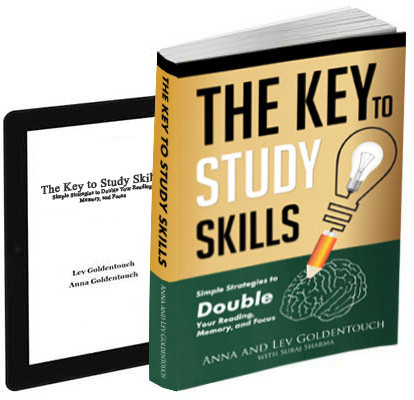If you practice visual memory and write, you have a chance to revisit your memory landscapes. It is not like simply revisiting the landscapes. When you fully draft the keywords anything missing or anything that should not belong becomes painfully visible. This is the ultimate challenge to your memory markers: create an entire text using almost only them. The feedback improves not just specific memory structures, but also the entire memorization process
Everything you need to remember is in your keywords.
I could not overestimate this claim. If you mark specific keywords from a text, you can ensure you remember these keywords. There is no guarantee whatsoever that you will remember anything else. If critical keywords are missing or the marked keywords do not form a full concept, the stuff you will remember is worthless. If there are extra keywords that can confuse, you are likely to be confused.
How many keywords per text?
Summarizing texts with several keywords can be hard. Some texts have no interesting idea and nothing to summarize. We may enjoy the reading and yet remember nothing of what we just read. Other texts may be extremely dense with multiple sets of multiple keywords.
Typically almost any idea can be summarized with 10 keywords: 3 keywords for context, 3 keywords for innovation, and 4 keywords for details and factoids. Some articles have zero innovative ideas, other articles may have 5. If you find more than 5 innovative ideas in an article this means you do not know the subject and need to read more background materials.
Then you may want to remember some supporting information, like names of the authors, numerical results, specifics of chosen methodology and so on. These are not really new ideas, but they can be memorized as additional information.
Overview articles tend to have zero new ideas but large amounts of additional information. Important articles usually have one main idea and a couple of tricks that enable the implementation of the main idea. Motivational reading may have zero ideas, and really nothing to remember.
Chunking the keywords
Typically we do not remember a list of 10 main keywords and 20 keywords describing additional factoids. This representation would be hard for visualization and recall. Instead, we group the keywords in small groups between 3 and 5 keywords. For example, we separate the title, context that does not appear in the title, innovative ideas, names of the authors, and key statistics. As a result, we get a list of say 10 groups of keywords, 3 to 5 words per group.
If you are familiar with mental palaces, each chunk of 3 to 5 words becomes a PAO visualization, a group of 3 to 5 visualization becomes a room and 3 to 7 rooms represent entire articles as a small palace.
If you are less proficient, you can generate a mindmap instead: the name of the article, the context, the innovation, the factoids, and each such branch with multiple subbranches. If you cannot visualize effectively, you still can create sentences using these keyword chunks, and a story from these sentences.
Reviewing landscapes
I can read and memorize 1000 articles in a day. This creates long streets with multiple somewhat similar memory palaces. There are some tricks that make each memory palace and each memory street unique and memorable. I teach the tricks in the masterclasses. Suppose you do not use the tricks. You still want to verify that you remember everything.
The best way to remember something is by writing down that something. Quite often the context, the innovation and the link to the article will do the trick. If we forget some factoids and details, we can later reread the article and recreate the details.
The visualization is typically guided by the keywords we write down, but we should visualize the entire mental palace with all relevant keywords. Possibly, the day after the original reading we may add further details to the mental structures to make them more descriptive and memorable.
The role of speedwriting
Speedwriting is a curious concept and it has several roles:
- I can write original articles and larger content relatively fast. This is very comfortable. I have to maintain several blogs, in addition to writing books in addition to full-time job in a startup company. If I was not using time optimization tools, I could never do that.
- I can formulate complex ideas in a memorable way. Even though I have a great memory, I tend to forget the thoughts I had two decades ago. When these thoughts are written they are unforgettable and searchable.
- The formal “spaced repetition” concept is tedious, and it can be removed.
In speedwriting process, I rely almost exclusively on keyword-based summarization of the content I read.
Chunking for speedwriting
For speedwriting, I usually select between 4 and 8 articles I already read as research material. An article I read may appear in several articles I write, typically playing a different role in each. This means that in one article I may address the innovation, while in another the experimental results, or may compare the premises of multiple articles.
Whenever I write an article, I tend to create a mental street where I place copies of all relevant mental palaces. This means that a copy of the same mental palace with everything in it may appear on multiple mental streets. And this in addition to the original placement of the mental palace based on my reading preferences. The multiple instances of the mental palace ensure the survivability of the ideas that are used on multiple occasions. Something that is not used appears only on one mental street and is more likely to be forgotten.
Long-term memorization and recall
Once we read the article, it remains a short-term impression. This short-term impression usually does not last more than a day. If I read 1000 articles in a day, I do not remember what I read half an hour ago without supporting keywords. Without the keywords written in a reading diary, I cannot recall anything of what I read in a reading spree.
Writing is different. I do not usually write more than 20 pages per day. This means 4 long-format articles of 10 shorter pieces. The ideas that are embedded in the memory landscapes of the articles I write become unforgettable for me. The recall is also easier, even if it may rely on google search.
Thus I can remember the stuff I read for half an hour of short-term memory. I can recall using the main keywords for approximately a day. Then after 5-6 recalls, I remember for approximately a year. But if the article I read is placed into something I write, I can remember it for more than a decade.
Rereading key articles
Some articles deserve to be reread even if I can recall the article. The devel lies in the details. After using the article in writing I tend to remember the aspects of the article that were addressed in writing. I do not remember the entire article. Here, the rereading helps. I can add keywords that did not appear in the original summary, including things I could not notice during the original reading.
We may want to think that we do not change much. This is not true for those of us who create. As a part of the creative process, we change. We notice different things and appreciate things in new ways.
Rereading soon after the original reading may add further details. Rereading long after the original reading creates profoundly new perspectives, that can be encoded as new memory palaces. We can recall the memory palace of the original reading and the memory palace of the rereading based on the context.
Conclusion
Once we encode the article we read in a memory palace, our job is not done. We review the memory palace, recreating the content from the keywords we remember. Then we place the palace on multiple mental streets, representing our creative activities. And then we may want to reread the entire article and create an entirely new mental palace which may be used on new mental streets.

Get 4 Free Sample Chapters of the Key To Study Book
Get access to advanced training, and a selection of free apps to train your reading speed and visual memory

